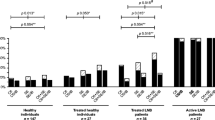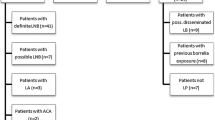Abstract
The usefulness of Western blot in the serological diagnosis of Lyme borreliosis was evaluated compared with an ELISA using a whole cell sonicate antigen. Fifty-three of 68 (78 %) patients with neuroborreliosis had positive IgM and/or IgG immunoblots and 40 of 68 (59 %) had positive IgM and/or IgG ELISA titers in serum. Eight of 44 (18 %) controls with meningitis/encephalitis of non-borrelia etiology had positive IgM and/or IgG immunoblots and 4 of 44 (9 %) had positive IgM and/or IgG ELISA titers in serum. Western blot was more sensitive than ELISA, the difference being most pronounced in sera from patients with neurological disease for four weeks or less. Both patients and controls lived in an area endemic for Lyme borreliosis and some ELISA negative but Western blot positive controls were thought to have been previously exposed toBorrelia burgdorferi. However, the specificity for current disease was not improved by Western blot. In conclusion, Western blot does not seem to be the method of choice for screening purposes in a routine laboratory but can be used as a complement to ELISA for serodiagnosis in patients with disease of short duration.
Similar content being viewed by others
References
Burgdorfer, W., Barbour, A. G., Hayes, S. F., Benach, J. L., Grunwaldt, E., Davis, J. P.: Lymc disease — a tick-borne spirochetosis? Science 1982, 216: 1317–1319.
Ackermann, R., Kabatzki, J., Boisten, H. P., Steere, A. C., Grodzicki, R. C., Hartung, S., Runne, U.: Spirochäten-Ätiologie der Erythema-chronicum-migrans Krankheit. Deutsche Medizinische Wochenschrift 1984, 109: 92–97.
Stiernstedt, G., Sköldenberg, B., Vandvik, B., Hederstedt, B., Gårde, A., Kolmodin, G., Jörbeck, H., Svenungsson, B.: Chronic meningitis and Lyme disease in Sweden. Yale Journal of Biology and Medicine 1984, 57: 491–497.
Åsbrink, E., Hovmark, A., Hederstedt, B.: The spirochetal etiology of acrodermatitis chronica atrophicans Herxheimer. Acta Dermato-Venereologica 1984, 64: 506–512.
Hovmark, A., Åsbrink, E., Olsson, I.: The spirochetal etiology of lymphadenosis benigna cutis solitaria. Acta Dermato-Venereologica 1986, 66: 479–484.
Olson, L. J., Okafor, E. C., Clements, I. P.: Cardiac involvement in Lyme disease: manifestations and management. Mayo Clinic Proceedings 1986, 61: 745–749.
Steere, A. C., Malawista, S. E., Hardin, J. A., Ruddy, S., Askenase, P. W., Andiman, W. A.: Erythema chronicum migrans and Lyme arthritis: the enlarging clinical spectrum. Annals of Internal Medicine 1977, 86: 685–698.
Steere, A. C., Grodzicki, R. L., Kornblatt, A. N., Craft, J. E., Barbour, A. G., Burgdorfer, W., Schmid, G. P., Johnson, E., Malawista, S. E.: The spirochetal etiology of Lyme disease. New England Journal of Medicine 1983, 308: 733–740.
Rawlings, J. A., Fournier, P. V., Teltow, G. J.: Isolation ofBorrelia spirochetes from patients in Texas. Journal of Clinical Microbiology 1987, 25: 1148–1150.
Craft, J. E., Grodzicki, R. L., Steere, A. C.: Antibody response in Lyme disease. Evaluation of diagnostic tests. Journal of Infectious Diseases 1984, 149: 789–795.
Russell, H., Sampson, J. S., Schmid, G. P., Wilkinson, H. P., Plikaytis, B.: Enzyme-linked immunosorbent assay and indirect immunofluorescence assay for Lyme disease. Journal of Infectious Diseases 1984, 149: 465–470.
Stiernstedt, G. T., Granström, M., Hederstedt, B., Sköldenberg, B.: Diagnosis of spirochetal meningitis by enzyme-linked immunosorbent assay and indirect immunofluorescence assay in serum and cerebrospinal fluid. Journal of Clinical Microbiology 1985, 21: 819–825.
Hansen, K., Hindersson, P., Strandberg Pedersen, N.: Measurement of antibodies to theBorrelia burgdorferi flagellum improves serodiagnosis in Lyme disease. Journal of Clinical Microbiology 1988, 26: 338–346.
Berardi, V. P., Weeks, K. E., Steere, A. C.: Serodiagnosis of early Lyme disease: analyses of IgM and IgG antibody responses by using an antibody-capture enzyme immunoassay. Journal of Infectious Diseases 1988, 158: 754–760.
Barbour, A. G., Burgdorfer, W., Grunwaldt, E., Steere, A. C.: Antibodies of patients with Lyme disease to components of theIxodes dammini spirochete. Journal of Clinical Investigation 1983, 72: 504–515.
Craft, J. E., Fisher, D. K., Shimamoto, G. T., Steere, A. C.: Antigens ofBorrelia burgdorferi recognized during Lyme disease. Appearance of a new immunoglobulin M response and expansion of the immunoglobulin G response late in the illness. Journal of Clinical Investigation 1986, 78: 934–939.
Karlsson, M., Möllegård, I., Stiernstedt, G., Henriksson, A. M., Wretlind, B.: Characterization of antibody response in patients withBorrelia meningitis. Serodiagnosis and Immunotherapy in Infectious Disease 1988, 2: 375–386.
Wilske, B., Schierz, G., Preac-Mursic, V.: Intrathecal production of antibodies againstBorrelia burgdorferi in patients with lymphocytic meningoradiculitis (Bann-warth's syndrome). Journal of Infectious Diseases 1986, 153: 304–314.
Wilske, B., Preac-Mursic, V., Schierz, G., Busch, K. V.: Immunochemical and immunological analysis of EuropeanBorrelia burgdorferi strains. Zentralblatt für Bakteriologie, Mikrobiologie und Hygiene (A) 1986, 263: 92–102.
Grodzicki, R. L., Steere, A. C.: Comparison of immunoblotting and indirect enzyme-linked immunosorbent assay using different antigen preparations for diagnosing early Lyme disease. Journal of Infectious Diseases 1988, 157: 790–797.
Sköldenberg, B., Stiernstedt, G., Gårde, A., Kolmodin, G., Carlström, A., Nord, C. E.: Chronic meningitis, caused by a penicillin-sensitive microorganism? Lancet 1983, ii: 75–78.
Stiernstedt, G.: Tick-borneBorrelia infection in Sweden. Scandinavian Journal of Infectious Diseases 1985, Supplement 45: 1–70.
Kyhse-Andersen, J.: Electroblotting of multiple gels: a simple apparatus without buffer tank for rapid transfer of proteins from polyacrylamid to nitrocellulose. Journal of Biochemical and Biophysical Methods 1984, 10: 203–209.
Hansen, K., Bangsborg, J. M., Fjordvang, H., Strandberg-Pedersen, N., Hindersson, P.: Immunochemical characterization of and isolation of the gene for aBorrelia burgdorferi immunodominant 60-kilodalton antigen common to a wide range of bacteria. Infection and Immunity 1988, 56: 2047–2053.
Author information
Authors and Affiliations
Rights and permissions
About this article
Cite this article
Karlsson, M., Möllegård, I., Stiernstedt, G. et al. Comparison of Western blot and enzyme-linked immunosorbent assay for diagnosis of Lyme borreliosis. Eur. J. Clin. Microbiol. Infect. Dis. 8, 871–877 (1989). https://doi.org/10.1007/BF01963773
Issue Date:
DOI: https://doi.org/10.1007/BF01963773




